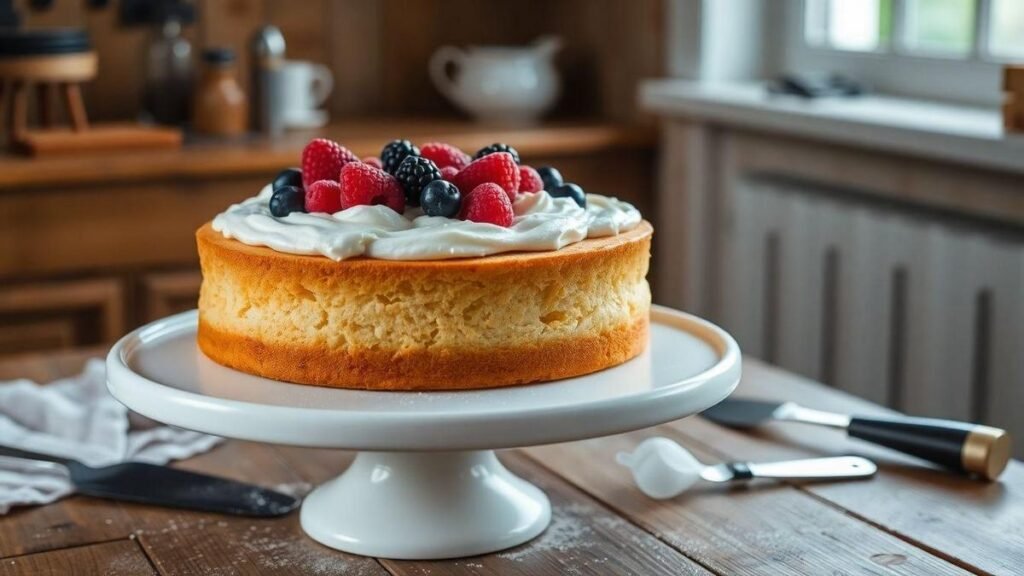I bake. I’ve watched cakes sink like tiny dessert volcanoes — and I’ve learned they can usually be saved. This guide shows how to disguise the dip with rich chocolate ganache, slice and stack into layers, turn scraps into a trifle, or make cake pops. I also share simple steps to prevent sinking next time (oven, mixing, and measuring fixes), plus a quick heat hack that sometimes rescues a fresh collapse. Don’t let a sunken cake sink your spirits.
Key takeaways
- Sunken cakes are common and usually salvageable
- Fill and frost, slice into layers, or repurpose into trifle or cake pops
- Quick emergency: gentle reheating can sometimes firm a slightly collapsed center
- Prevent by preheating, accurate measuring, not opening the oven early, and avoiding overmixing — and follow these foolproof oven tips
Easy tips to fix a cake that sinks in the middle
I follow recipes like a scientist, but sometimes a cake rises and then falls in the middle. I feel your sting — and I’ve learned a few quick fixes that make that sad cake sing again. Below are the practical steps I use.
What I do first
- Look and smell the cake — if it tastes fine, it’s probably salvageable.
- Act fast for heat-based fixes — some hacks work best while the cake is still warm.
Why does a cake sink in the middle?
Common causes and how to spot them:
- Underbaked center — soft, collapses; toothpick shows wet batter.
- Too much leavening (baking powder/soda) — rises fast then falls; may taste bitter or show big bubbles — one of the classic baking blunders.
- Too much sugar or liquid — weak structure; cake feels gummy.
- Oven temperature shock — opening the door causes collapse; cake drops after you peek. Follow practical oven-temperature tips to avoid this.
- Overmixing — gluten overdevelops, then cake collapses; dense crumb, slow spring-back. See common fixes in the baking blunders guide.
- Wrong pan size — batter too deep or shallow; edges overcook while center remains raw.
Can you fix a sunken cake?
Yes. Think of a sunken cake as a blank canvas with a dent. Pick a rescue based on how much time and frosting you have:
Rescue options
- Fill and Frost It — Best when the cake tastes fine but has a dip. Level the top, fill the dip with frosting or fruit, then cover with more frosting. Try a glossy finish with a chocolate ganache or a bright simple glaze.
- Make a Layer Cake — If the cake is stable enough, slice horizontally, add jam/buttercream, and stack; you can follow steps for building a layer cake without a mixer.
- Turn It Into a Trifle — Cut into cubes and layer with custard, fruit, and cream for a quick, pretty dessert; this is a great repurpose covered in tips for rescuing dry or sad cakes (trifle ideas and fixes).
- Cake Pops — Crumble the cake, mix with frosting, roll into balls, and dip in chocolate when the outside is too messy — a fun way to turn scraps into a party treat and another option in no-piping-bag decorating ideas.
Fill and Frost — my favorite quick cover-up
Tools and quick method:
- Knife — level the top.
- Spoon — scoop and fill the dip.
- Thick buttercream — seals and hides the low spot. For a shiny finish, try a glossy chocolate ganache or a bright simple glaze.
Anecdote: I once filled a huge dip with cherries and called it a volcano cake. People loved it. I didn’t admit the truth — but fruit-topped cakes are always a hit, and using fruit as a topping is a quick way to make a sunken center look intentional.
How to prevent a cake from sinking
Prevention beats repairs. My must-dos before batter hits the pan:
- Don’t open the oven door too soon — waits at least 3/4 of the baking time to avoid temperature loss; follow general oven-failure prevention.
- Test for doneness — toothpick should come out clean or with a few crumbs.
- Measure ingredients accurately — especially flour, sugar, and leavening. Use proper cups and spoons and the measuring advice in foolproof baking tips.
- Preheat your oven — wait until it reaches temp.
- Bake at the right temperature — verify with an oven thermometer.
- Mix batter just until combined — stop when the flour disappears; overmixing is covered in common baking blunders.
- Use the right pan size — follow the recipe to get the correct batter depth.
Quick measuring notes I keep in my head
- Flour: spoon into the cup and level off.
- Sugar: level cup (pack only for brown sugar).
- Baking powder/soda: measure precisely; small amounts matter.
- Eggs & liquids: use room temperature when the recipe asks.
Bonus tips that matter
- Room-temperature eggs and butter blend better and trap air evenly.
- Tap the pan on the counter to remove large air bubbles before baking.
- Line and grease pans so cakes lift cleanly and bake evenly — see more on avoiding oven mishaps in the foolproof tips.
- Use an oven thermometer — many ovens lie about actual temperature.
Short story: I forgot to preheat once and cranked the oven higher in a panic. The cake rose like an eagle and crashed like a sleepy kid. The oven does not like drama — learn from the common blunders.
A quick rescue hack
If the cake collapses immediately after baking, try this emergency move (works with slight sinks only):
- Cover the dip loosely with a sheet of foil.
- Return the cake to the oven at 300°F (150°C) for 5–10 minutes.
- Check; remove when the center feels slightly firm.
Don’t overdo it — this can firm the center but won’t fully restore a badly collapsed cake. For other last-minute fixes, see general baking rescue tips.
Summary: Don’t let a sunken cake sink your spirits
Turn a sad middle into a feature: frost, layer, or crumble it into another dessert. Baking is part science, part improv — learn, laugh, and keep chocolate on standby.
Related posts
Menu & Categories
- Contact
Conclusion
I’ve seen cakes collapse like tiny dessert sinkholes — and I’ve saved them more times than I’d like to admit. My go-to fixes are a quick fill-and-frost or the emergency heat hack when the center is still salvageable. Prevention — preheat, measure, don’t open the oven early, and stop mixing when the flour disappears — gives the biggest payoff. Baking is half science, half improvisational theater. I laugh at the disasters, learn from them, and keep chocolate on standby. For more rescue missions and practical tips, keep reading at https://xendrie.com.
Frequently asked questions
Q: Why did my cake sink in the middle?
A: Common causes are too much leavening, underbaking, overmixing, opening the oven too soon, or the oven being too cool.
Q: Can I still use a sunken cake?
A: Yes. Most are fine to eat. You can hide or repurpose the dip — nobody will mind.
Q: What is a quick rescue right after it collapses?
A: Cover the dip with foil and pop the cake back in the oven at 300°F (150°C) for 5–10 minutes. This can sometimes firm it up.
Q: How do I turn a sunken cake into a layer cake?
A: Slice the cake horizontally, add jam, ganache, or buttercream between layers, then stack and frost. For step-by-step stacking without a mixer, see layer-cake techniques.
Q: How do I stop cakes from sinking next time?
A: Preheat the oven, measure ingredients accurately, don’t open the oven door early, test for doneness with a toothpick, and mix only until combined — and review these foolproof baking tips.






